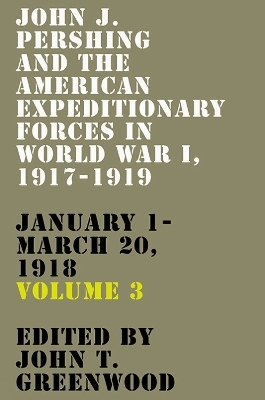
John J. Pershing and the American Expeditionary Forces in World War I, 1917-1919
January 1-March 20, 1918
Seiten
2024
The University Press of Kentucky (Verlag)
978-0-8131-9663-3 (ISBN)
The University Press of Kentucky (Verlag)
978-0-8131-9663-3 (ISBN)
Pershing and the American Expeditionary Forces in World War I, 1917-1919 covers the period of January 1 through March 20, 1918, as General Pershing encounters logistical and organizational challenges that originated in the last months of 1917.
General of the Armies John J. Pershing (1860–1948) had a long and decorated military career but is most famous for leading the American Expeditionary Forces in World War I. He published a memoir, My Experiences in the World War, and has been the subject of numerous biographies, but the literature regarding this towering figure and his enormous role in the First World War deserves to be expanded to include a collection of his wartime correspondence.
Carefully edited by John T. Greenwood, volume 3 of John J. Pershing and the American Expeditionary Forces in World War I, 1917–1919 covers the period of January 1 through March 20, 1918, as General Pershing encounters logistical and organizational challenges that originated in the last months of 1917/. With the collapse of the Eastern Front and Allied defeats in Italy, British and French commanders were preparing for a renewed German offensive and proposed that American troops be put under their control for training and frontline combat in order to replenish losses. Pershing's diary entries indicate that he rejected these proposals and yet offered four segregated African American regiments to be placed under French control. The conclusion of the AEF autonomy debate allowed Pershing to focus on reorganizing the General Headquarters of the AEF, establishing effective communication lines, and contracting Allied European governments to produce armaments for the AEF with American raw materials. In March 1918, Maj. Gen. Peyton C. March replaced Gen. Tasker H. Bliss as chief of staff. The sources included in this edition show the origin of Pershing and March's personal feud, which persisted well after the war.
Pershing's letters during this time period convey a long and arduous struggle to build an American army at the front. Together, these volumes of wartime correspondence provide new insight into the work of a legendary soldier and the historic events in which he participated.
General of the Armies John J. Pershing (1860–1948) had a long and decorated military career but is most famous for leading the American Expeditionary Forces in World War I. He published a memoir, My Experiences in the World War, and has been the subject of numerous biographies, but the literature regarding this towering figure and his enormous role in the First World War deserves to be expanded to include a collection of his wartime correspondence.
Carefully edited by John T. Greenwood, volume 3 of John J. Pershing and the American Expeditionary Forces in World War I, 1917–1919 covers the period of January 1 through March 20, 1918, as General Pershing encounters logistical and organizational challenges that originated in the last months of 1917/. With the collapse of the Eastern Front and Allied defeats in Italy, British and French commanders were preparing for a renewed German offensive and proposed that American troops be put under their control for training and frontline combat in order to replenish losses. Pershing's diary entries indicate that he rejected these proposals and yet offered four segregated African American regiments to be placed under French control. The conclusion of the AEF autonomy debate allowed Pershing to focus on reorganizing the General Headquarters of the AEF, establishing effective communication lines, and contracting Allied European governments to produce armaments for the AEF with American raw materials. In March 1918, Maj. Gen. Peyton C. March replaced Gen. Tasker H. Bliss as chief of staff. The sources included in this edition show the origin of Pershing and March's personal feud, which persisted well after the war.
Pershing's letters during this time period convey a long and arduous struggle to build an American army at the front. Together, these volumes of wartime correspondence provide new insight into the work of a legendary soldier and the historic events in which he participated.
John T. Greenwood is former chief of the Office of Medical History, Office of the Surgeon General, U.S. Army. He is the editor of several books, including Normandy to Victory: The War Diary of General Courtney H. Hodges and the First U.S. Army and My Life before the World War, 1860-1917: A Memoir (written by John J. Pershing). He lives in Annandale, Virginia.
Introduction to the Collection
Introduction to Volume 3
January 1918
February 1918
March 1918
Bibliography
Index
| Erscheinungsdatum | 23.12.2023 |
|---|---|
| Zusatzinfo | 4 maps, 3 charts, 31 tables, 20 b&w illustrations |
| Verlagsort | Lexington |
| Sprache | englisch |
| Maße | 156 x 235 mm |
| Themenwelt | Geschichte ► Allgemeine Geschichte ► Neuzeit (bis 1918) |
| Sozialwissenschaften ► Politik / Verwaltung | |
| ISBN-10 | 0-8131-9663-9 / 0813196639 |
| ISBN-13 | 978-0-8131-9663-3 / 9780813196633 |
| Zustand | Neuware |
| Haben Sie eine Frage zum Produkt? |
Mehr entdecken
aus dem Bereich
aus dem Bereich
Europa 1848/49 und der Kampf für eine neue Welt
Buch | Hardcover (2023)
DVA (Verlag)
CHF 67,20
Giordano Bruno - ein ketzerisches Leben
Buch | Hardcover (2024)
C.H.Beck (Verlag)
CHF 41,85


